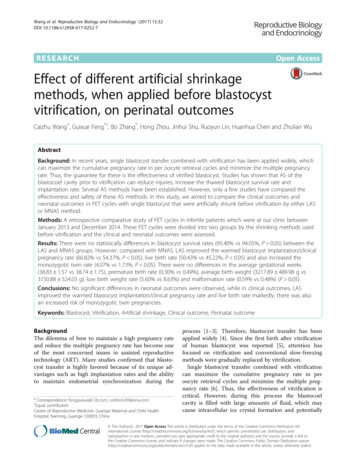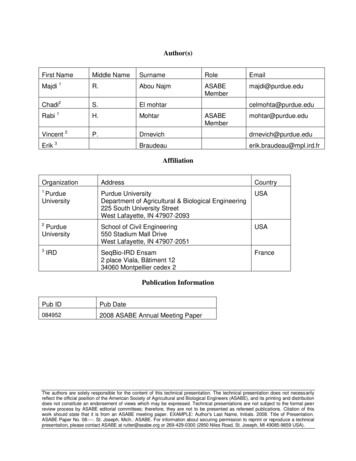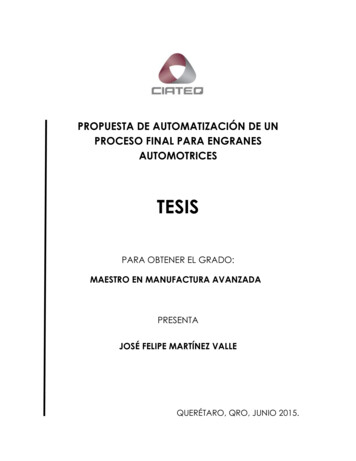
Transcription
Wang et al. Reproductive Biology and Endocrinology (2017) 15:32DOI 10.1186/s12958-017-0252-7RESEARCHOpen AccessEffect of different artificial shrinkagemethods, when applied before blastocystvitrification, on perinatal outcomesCaizhu Wang†, Guixue Feng*†, Bo Zhang*, Hong Zhou, Jinhui Shu, Ruoyun Lin, Huanhua Chen and Zhulian WuAbstractBackground: In recent years, single blastocyst transfer combined with vitrification has been applied widely, whichcan maximize the cumulative pregnancy rate in per oocyte retrieval cycles and minimize the multiple pregnancyrate. Thus, the guarantee for these is the effectiveness of vitrified blastocyst. Studies has shown that AS of theblastocoel cavity prior to vitrification can reduce injuries, increase the thawed blastocyst survival rate andimplantation rate. Several AS methods have been established. However, only a few studies have compared theeffectiveness and safety of these AS methods. In this study, we aimed to compare the clinical outcomes andneonatal outcomes in FET cycles with single blastocyst that were artificially shrunk before vitrification by either LASor MNAS method.Methods: A retrospective comparative study of FET cycles in infertile patients which were at our clinic betweenJanuary 2013 and December 2014. These FET cycles were divided into two groups by the shrinking methods usedbefore vitrification and the clinical and neonatal outcomes were assessed.Results: There were no statistically differences in blastocyst survival rates (95.40% vs 94.05%, P 0.05) between theLAS and MNAS groups. However, compared with MNAS, LAS improved the warmed blastocyst implantation/clinicalpregnancy rate (60.82% vs 54.37%, P 0.05), live birth rate (50.43% vs 45.22%, P 0.05) and also increased themonozygotic twin rate (4.07% vs 1.73%, P 0.05). There were no differences in the average gestational weeks(38.83 1.57 vs 38.74 1.75), premature birth rate (0.30% vs 0.49%), average birth weight (3217.89 489.98 g vs3150.88 524.03 g), low birth weight rate (5.60% vs 8.63%) and malformation rate (0.59% vs 0.48%) (P 0.05).Conclusions: No significant differences in neonatal outcomes were observed, while in clinical outcomes, LASimproved the warmed blastocyst implantation/clinical pregnancy rate and live birth rate markedly, there was alsoan increased risk of monozygotic twin pregnancies.Keywords: Blastocyst, Vitrification, Artificial shrinkage, Clinical outcome, Perinatal outcomeBackgroundThe dilemma of how to maintain a high pregnancy rateand reduce the multiple pregnancy rate has become oneof the most concerned issues in assisted reproductivetechnology (ART). Many studies confirmed that blastocyst transfer is highly favored because of its unique advantages such as high implantation rates and the abilityto maintain endometrial synchronization during the* Correspondence: fengguixue@126.com; cestbon269@sina.com†Equal contributorsCenter of Reproductive Medicine, Guangxi Maternal and Child HealthHospital, Nanning, Guangxi 530003, Chinaprocess [1–3]. Therefore, blastocyst transfer has beenapplied widely [4]. Since the first birth after vitrificationof human blastocyst was reported [5], attention hasfocused on vitrification and conventional slow-freezingmethods were gradually replaced by vitrification.Single blastocyst transfer combined with vitrificationcan maximize the cumulative pregnancy rate in peroocyte retrieval cycles and minimize the multiple pregnancy rate [6]. Thus, the effectiveness of vitrification iscritical. However, during this process the blastocoelcavity is filled with large amounts of fluid, which maycause intracellular ice crystal formation and potentially The Author(s). 2017 Open Access This article is distributed under the terms of the Creative Commons Attribution 4.0International License (http://creativecommons.org/licenses/by/4.0/), which permits unrestricted use, distribution, andreproduction in any medium, provided you give appropriate credit to the original author(s) and the source, provide a link tothe Creative Commons license, and indicate if changes were made. The Creative Commons Public Domain Dedication o/1.0/) applies to the data made available in this article, unless otherwise stated.
Wang et al. Reproductive Biology and Endocrinology (2017) 15:32Page 2 of 6lethal damage of the embryo during cooling by influencing the dehydration shrinkage rate. Studies has shownthat artificial shrinkage (AS) of the blastocoel cavityprior to vitrification can reduce injuries due to chillingand increase the rates of thawed blastocyst survival andimprove the implantation and pregnancy rate remarkably [7–10]. Therefore AS has been used widely prior tovitrification. Several AS methods have been established,such as micro-needle AS (MNAS), micro-pipetting AS,29-gauge needle and laser pulse AS (LAS), which cansignificantly improve the thawed blastocyst survival rateand clinical pregnancy rate [10–12]. However, only a fewstudies focused on the comparison of these AS methods.In this study, we compared the clinical outcomes andneonatal outcomes in frozen embryo transfer (FET)cycles with single blastocyst that were artificially shrunkbefore vitrification by either LAS or MNAS.o’clock. An injection needle was used to pierce throughthe expanded blastocyst from the area with the leastnumber of trophoblast cells. The fluid in the blastocoelcavity flowed out during the process of needle injectionaspiration, resulting in rapid shrinkage of the blastocyst.MethodsVitrification The blastocysts were placed into 200 μLHEPES-buffered culture medium (Quinn’s-1023, SAGE,USA) supplemented with 20% human serum albumin(HSA, SAGE, USA) and rinsed for 30s. Then this wasmoved into a 200 μL droplet of equilibration solutioncontaining 10% (v/v) ethylene glycol (American SIGMA)and 10% (v/v) DMSO (American SIGMA) for 1 min incubation. After that, the blastocyst was transferred to a200 μL droplet of vitrification solution containing 20%(v/v) ethylene glycol, 20% (v/v) DMSO and 0.3 mol/Lsucrose (American SIGMA) for 30s, and then a microdroplet ( 0.5 μL) with the blastocyst was sucked into theglass micro-pipette by a siphoning effect, and the micropipette was plunged into liquid nitrogen immediately forcryopreservation.Patients and FET dataPatients were recruited from January 2013 to December2014, who underwent single frozen blastocyst transfer.Inclusion criteria: the warmed blastocysts graded to atleast B for both trophectoderm and inner cell mass(ICM), the blastocoele expanded at least to stage III, firstor second FET cycle and a single blastocyst transferred.The grade of blastocyst was conducted according to theGardner’s grading system [13]. Of the 1552 FET cyclescontaining 1638 blastocysts used in this study, 790 blastocysts were assigned to the MNAS group (vitrificationafter MNAS) and 848 blastocysts were from the LASgroup (vitrification after LAS).MethodsEmbryo culture and blastocyst formationQuinn’s medium was used for embryo culture. Theembryo transfer strategy was performed with informedconsent according to day 3 embryo quality and patients’conditions. The day of oocyte retrieval was consideredas day 0. If patients chosen D3 cleavage embryo transfer,then supernumerary embryos were cultured to day 5 or6. If patients agreed to performed blastocyst culture, allembryos would be transferred into blastocyst culturemedium. After day 5 of embryo transfer, all theremaining blastocysts graded at least BC or CB thatreached stage 3 or more on day 5 or 6 according to theGardner’s grading system [13] were vitrified.Artificial shrinkage of the blastocystArtificial shrinkage of the blastocoel was induced by applying MNAS or LAS at room temperature (24 2 C).Micro-needle AS A holding needle was used to stabilizethe blastocyst, with the ICM at the direction of 12 or 6Laser pulse AS Using the RI Saturn Laser System(England), one single laser shot (409 μs) was delivered toone of the trophoblast cells, while the ICM was positionedfar from the shooting spot. Repeated micro-pipetting witha hand-drawn Pasteur pipette helps to achieve completeshrinkage of the blastocyst.Vitrification and thawing of blastocystVitrification and warming were performed according tothe methods established by our clinic and describedpreviously [14].Thawing On the day of transfer in FET cycles, blastocysts were warmed. For warming, a petri dish containing200 μL droplets with four different thawing solutions(TS1 0.6 mol/L sucrose in HEPES-buffered media supplemented with 20% HAS, TS2 0.5 molL/L sucrose inHEPES-buffered media supplemented with 20% HAS,TS3 0.25 mol/L sucrose in HEPES-buffered media supplemented with 20% HAS and TS4 HEPES-bufferedmedia supplemented with 20% HSA) were made andthen kept at 37 C. For warming, the capillary end of theglass micro-pipette with blastocyst was placed into theTS1 quickly, then the blastocyst was released from thecapillary and incubated for 2 min. Then, the blastocystwas incubated in TS2 for 3 min, in TS3 for 3 min and inTS4 for 5 min. After warming, the blastocyst was transferred to the blastocyst culture medium and cultured for2–4 h in the incubator to assess its morphological survival. If the blastocyst was damaged severely with morethan half cells showing signs of damage or the blastocystwas regressing with no signs of re-expansion [15], an
Wang et al. Reproductive Biology and Endocrinology (2017) 15:32Page 3 of 6extra one was warmed immediately if the patient had another frozen blastocyst in reserve. Otherwise, the FETcycle was be cancelled.Statistical analysisStatistical analysis was completed with the SPSS 13.0package. Data are summarized with the use of means SD.The means were compared by analysis of variance(ANOVA) and proportional data were compared in χ2analysis. P 0.05 was considered statistically significant.Quality evaluation of warmed blastocystThe quality of warmed blastocyst was assessed 2–4 hpost-culture on the inverted microscope by two independent embryologists according to the Gardner’scriteria [13].ResultsCharacteristics of patientsAs shown in Table 1 the mean age of patients, averageduration of infertility, mean number of cycles, frequencyof abortion, BMI, basic FSH, basic LH, endometrialpreparation and average endometrial thickness on theday of embryo transfer were not statistically significantbetween the MNAS and LAS groups (P 0.05). Therewas no difference in average number of blastocysts thatwere frozen and the mean number of embryos producedbefore blastocyst formation (P 0.05).Transfer of warmed blastocystThe common modality for FET were the natural cyclesor hormone replacement cycles for endometrial preparation. Blastocyst transfer was performed under ultrasound guidance using an embryo transfer catheter onday 6 after ovulation or progesterone injection. Aftertransplantation, intramuscular injection of progesteronewas administered as a routine scheme for luteal support.Comparison of clinical outcomeIn the LAS group, there were 809 FET cycles containing848 warmed blastocysts, of which 809 survived (survivalrate was 95.40%). In the MNAS group, there were 743FET cycles including 790 blastocysts, of which 743survived (survival rate was 94.05%). No difference in thisrate was detected(95.40% vs 94.05%, P 0.05). Theimplantation rates/clinical pregnancy rates (60.82% vs54.37%) and live birth rates (50.43% vs 45.22%) in theLAS group were significantly higher than the MNASgroup (P 0.05). However, the incidence rates of monozygotic twins in the LAS group were also significantlyhigher than the MNAS group (4.07% vs 1.73%, P 0.05).There was no statistically significant in the abortionrates and ectopic pregnancy rates between these twogroups (P 0.05; Table 2).Follow-up and evaluation indexOn the 14th day post-transfer, patients whose serum HCGwere positive were identified as positive for a biochemicalpregnancy. On the 28th day post-transfer, the gestationalsac was monitored by trans-vaginal ultrasound to confirmthe clinical pregnancy. In mid-trimester pregnancy andthird trimester pregnancy, details of the patients’ ongoingpregnancy were recorded by a follow-up phone call. Livebirth rate was defined as live birth delivery cycles dividedby transfer cycles. Less than 32 gestational weeks was defined as premature birth and 28 weeks as very prematurebirth. Birth weight lower than 2,500 g was defined as lowbirth weight and birth weight lower than 1,500 g wasdefined as very low birth weight.Table 1 Basic clinical data from subjects in this studyMicro-needle ASLaser pulse ASPFET cycles (n)743809——Age (y)30.75 3.4930.53 3.380.203Infertility duration (y)3.65 2.743.87 2.880.120Times of abortion0.72 0.910.71 0.980.933BMI (kg/m2)20.89 2.4321.13 2.500.056Endometrial thickness (mm)9.44 1.779.47 1.770.765Basal FSH (IU/L)6.95 1.786.81 1.680.111Basal LH (IU/L)5.81 3.125.82 3.670.967Percentage of natural cycle66.08 (491/743)61.93 (501/809)0.089Mean number of frozen blastocysts5.09 3.305.18 3.400.204Mean number of embryos used for culture blastocyst11.72 6.0911.99 6.130.428Mean number of cycles1.19 0.391.17 0.370.0714Mean number of collected oocytes16.83 7.2117.47 7.590.077
Wang et al. Reproductive Biology and Endocrinology (2017) 15:32Page 4 of 6Table 2 Analysis of clinical outcomeMicro-needle ASLaser pulse ASFET cycles (n)743809Blastocyst survival rate (%)94.05 (743/790)95.40 (809/848)P0.221Mean number of blastocysts thawed1.07 0.261.05 0.210.096Implantation/pregnancy rate (%, n)54.37 (404/743)60.82 (492/809)0.010Monozygotic twin rate (%, n)1.73 (7/404)4.07 (20/492)0.042Ectopic pregnancy rate (%, n)0.74 (3/404)1.22 (6/492)0.7070.741Abortion rate (%, n)15.84 (64/404)15.04 (74/492)Delivery cycles337412Live birth cycles336408Stillbirth cycles14Live birth rate (%, n)45.22 (336/743)50.43 (408/809)Comparison of neonatal outcomeAs shown in Table 3 a total of 339 babies were born in336 live birth cycles in the MNAS group, and 417 babieswere born in 408 live birth cycles in the LAS group.There were no differences with respect to the averagegestational weeks (38.83 1.57w vs 38.74 1.75w), meanbirth weight (3217.89 489.98 g vs 3150.88 524.03 g),premature birth rates (0.30% vs 0.49%), low weight rates(5.60% vs 8.63%) and very low weight rates (0.29%0.72%) between the MNAS and LAS groups (P 0.05).The malformation rates in the MNAS and LAS groupsrespectively were 0.59% and 0.48%, there was also nodifference (P 0.05).DiscussionLarge amounts of fluid in blastocoelic cavity may influence the permeation of cryoprotectant during vitrification, which may cause intracellular ice crystal formationand result in adverse impact on blastocyst viability. AScan induce rapid collapse of the blastocoel and improvethe warmed blastocyst survival rate. Many studies0.040have confirmed that AS of expanded blastocyst priorto vitrification can remarkably increase the blastocystsurvival rate, implantation rate and clinical pregnancyrate [7–11]. Therefore, AS has been widely applied invitrification of the blastocyst. It was also found thatAS pre-processing can also be applied prior to thefresh blastocyst transfer to improve the clinical outcome by selecting the most rapid re-expansion blastocyst [16]. So, it seems that AS does not cause damageto the blastocyst.The AS methods commonly used currently are MNAS[7], micro-pipetting AS [8], LAS [9] and 29-gauge needleAS [12]. All these AS methods have been shown to improve blastocyst survival rate, implantation rate andpregnancy rate [7, 9, 11, 12, 17, 18]. However, only a fewstudies focused on the comparison of these AS methodswhen applied prior to vitrification. Therefore, we conducted a comprehensive study using 1552 FET cyclesfrom January 2013 to December 2014 with detailedmedical record and, intended to compare the influenceof the MNAS and LAS methods when applied beforeblastocyst vitrification.Table 3 Analysis of neonatal outcomePMicro-needle ASLaser pulse ASLive birth cycles336408Number of babies339417Mean gestational age (weeks)38.83 1.5738.74 1.750.479Premature birth rate (%, n)0.30 (1/336)0.49 (2/408)1.000Very premature birth rate (%)00Mean birth weight (g)3217.89 489.983150.88 524.030.072Low weight rate (%, n)5.60 (19/339)8.63 (36/417)0.111Very low weight rate (%, n)0.29 (1/339)0.72 (3/417)0.767Malformation rate (%, n)0.59 (2/339)0.48 (2/417)1.000
Wang et al. Reproductive Biology and Endocrinology (2017) 15:32The results showed that the blastocyst survival rateswere similar, but the blastocyst implantation rate andclinical pregnancy rate in the LAS group was significantly higher than the MNAS group. However, Mukaidaet al. found that LAS and MNAS could achieve similarblastocyst survival rates, implantation rates and abortionrates [9]. Van Landuyt et al. conducted a prospectiverandomized controlled trial and showed that the LASmethod improved blastocyst survival rate markedly, butfailed to increase the implantation rate of post-warmedblastocyst [19]. These results were inconsistent withours. It can be speculated that MNAS may cause moredamage to the trophoderm, which plays an importantrole in implantation, relative to that caused by the LASmethod. Desai found that there was a trend of a fasterand higher re-expansion rate after LAS compared withMNAS [20]. Faster and higher re-expansion can be astrong predictor of clinical pregnancy outcome [21]. So,this may be a good explanation for the high implantationrate of post-warmed blastocyst artificial shrinkage bylaser. In addition, in our hands artificial shrinkage bylaser is a more time-saving procedure.Currently, the safety aspects of AS remain controversial. Most of the published research data involve nomore than clinical outcome parameters, with very littledata regarding analysis on neonatal outcomes. A studyshowed that using the 29-gauge needle AS methodresulted with a higher premature birth rate (40.00% vs.21.15%, P 0.05) when compared with an LAS group[22]. Levi-Setti et al., found that MNAS did not increasethe abortion rate, premature birth rate and low birthweight rate [23]. Our results also showed similarneonatal outcomes in the LAS and MNAS groups. Thepremature birth rates and low birth weight rate in theMNAS and LAS groups were 0.3% vs 0.49% and 5.6% vs8.63% respectively. The neonatal outcome parameters ofpremature birth rate and low birth weight rate in ourstudy was lower compared with those observed byothers and this may be derived from the benefit of usingsingle blastocyst transfer in our study, which can markedly reduce the risk of multiple pregnancy and otherassociated complications.In this study, the LAS group showed significantlyincreased blastocyst implantation rate, but this was alsolinked with a significantly increased monozygotic twinrate. Monozygotic twins are associated with a range ofwell-documented risks associated with the health of themother and fetus. The rate of monozygotic twinning inthe population in thought to be fairly low. However, therate is increased in assisted reproductive technology[24, 25]. Some research showed that the incidence ofmonozygotic twinning may be affected by micromanipulating the zona pellucida, in such procedures asICSI and assisted hatching [26, 27]. Thus the rate ofPage 5 of 6monozygotic twinning increased in the LAS group andthis may be associated with the damage of the zona pellucida, creating a hole greater than the micro-needlepuncture.ConclusionsOur results showed that LAS and MNAS of blastocoeleprior to vitrification can both achieve favorable clinicaland neonatal outcomes. Despite no differences in neonataloutcome, LAS appears to improve blastocyst implantationrate and live birth rate significantly compared withMNAS, but there is also an increased risk of producingmonozygotic twins. Therefore, from this study we cannotmake a conclusive decision on which method is better.For a more definitive conclusion and to assess the safetyof artificial shrinkage a prospective randomized trial isneeded.AbbreviationsART: Assisted reproductive technology; DMSO: Dimethyl sulfoxide;FET: Frozen embryo transfer; HAS: Human serum albumin; HCG: Humanchorionic gonadotropin; ICM: Inner cell mass; ICSI: Intracytoplasmic sperminjection; LAS: Laser pulse artificial shrinking; MNAS: Micro-needle artificialshrinking; TS: Thawing solutionAcknowledgementsWe thank the clinicians, clinical embryologists, laboratory technologists andnurses of the Centre of Reproductive Medicine for data collection andDr. Dev Sooranna, Imperial College London, for editing the manuscript.FundingThis work was supported by a project grant from the Natural ScienceFoundation of Guangxi Province (Project# 2013GXNSFAA019258), a projectgrant from the Research Foundation of Guangxi Medical and Health(Project# S201612) and a project grant from the Self-raised Foundation ofGuangxi Health Commission (Project #Z2016093).Availability of data and materialsPlease contact author for data requests.Authors’ contributionsCW and GF participated in the design of the study, performed the statisticalanalysis and drafted the manuscript. GF, BZ, HZ and JS carried out theclinical and laboratory operations in this study. RL, HC and ZW helped toperform the laboratory operations. All authors read and approved the finalmanuscript.Competing interestsThe authors declare that they have no competing interest.Consent for publicationNot applicable.Ethics approval and consent to participateThe study was approved by the Ethics Committee of Guangxi Maternal andChild Health institution. All patients signed informed consents regarding ART.Publisher’s NoteSpringer Nature remains neutral with regard to jurisdictional claims inpublished maps and institutional affiliations.
Wang et al. Reproductive Biology and Endocrinology (2017) 15:32Received: 5 February 2017 Accepted: 20 April 2017References1. Papanikolaou EG, Camus M, Kolibianakis EM, Van Landuyt L, VanSteirteghem A, Devroey P. In vitro fertilization with single blastocyst-stageversus single cleavage-stage embryos. N Engl J Med. 2006;354:1139–46.2. Fanchin R, Ayoubi JM, Righini C, Olivennes F, Schonauer LM, Frydman R.Uterine contractility decreases at the time of blastocyst transfers. HumReprod. 2001;16:1115–9.3. Papanikolaou EG, Kolibianakis EM, Tournaye H, Venetis CA, Fatemi H,Tarlatzis B, Devroey P. Live birth rates after transfer of equal number ofblastocysts or cleavage-stage embryos in IVF. A systematic review andmeta-analysis. Hum Reprod. 2008;23:91–9.4. Practice Committees of the American Society for Reproductive M, theSociety for Assisted Reproductive T. Blastocyst culture and transfer inclinical-assisted reproduction: a committee opinion. Fertil Steril.2013;99:667–72.5. Yokota Y, Sato S, Yokota M, Ishikawa Y, Makita M, Asada T, Araki Y.Successful pregnancy following blastocyst vitrification: case report.Hum Reprod. 2000;15:1802–3.6. Wu CH, Lee TH, Chen HH, Chen CI, Huang CC, Lee MS. The influence offemale age on the cumulative live-birth rate of fresh cycles and subsequentfrozen cycles using vitrified blastocysts in hyper-responders. Taiwan J ObstetGynecol. 2015;54:567–71.7. Vanderzwalmen P, Bertin G, Debauche C, Standaert V, van Roosendaal E,Vandervorst M, Bollen N, Zech H, Mukaida T, Takahashi K, Schoysman R.Births after vitrification at morula and blastocyst stages: effect of artificialreduction of the blastocoelic cavity before vitrification. Hum Reprod.2002;17:744–51.8. Hiraoka K, Hiraoka K, Kinutani M, Kinutani K. Blastocoele collapse bymicropipetting prior to vitrification gives excellent survival and pregnancyoutcomes for human day 5 and 6 expanded blastocysts. Hum Reprod.2004;19:2884–8.9. Mukaida T, Oka C, Goto T, Takahashi K. Artificial shrinkage of blastocoelesusing either a micro-needle or a laser pulse prior to the cooling steps ofvitrification improves survival rate and pregnancy outcome of vitrifiedhuman blastocysts. Hum Reprod. 2006;21:3246–52.10. Joo JK, Jeong JE, Kim SC, Kim CW, Ko GR, Lee KS. Comparison ofmechanical artificial shrinkage methods in mouse blastocyst vitrification.Clin Exp Obstet Gynecol. 2016;43:93–7.11. Darwish E, Magdi Y. Artificial shrinkage of blastocoel using a laser pulseprior to vitrification improves clinical outcome. J Assist Reprod Genet.2016;33:467–71.12. Son WY, Yoon SH, Yoon HJ, Lee SM, Lim JH. Pregnancy outcome followingtransfer of human blastocysts vitrified on electron microscopy grids afterinduced collapse of the blastocoele. Hum Reprod. 2003;18:137–9.13. Gardner DK, Lane M, Stevens J, Schlenker T, Schoolcraft WB. Blastocyst scoreaffects implantation and pregnancy outcome: towards a single blastocysttransfer. Fertil Steril. 2000;73:1155–8.14. Feng G, Zhang B, Zhou H, Shu J, Gan X, Wu F, Deng X. Comparable clinicaloutcomes and live births after single vitrified-warmed and fresh blastocysttransfer. Reprod Biomed Online. 2012;25:466–73.15. Van Landuyt L, Stoop D, Verheyen G, Verpoest W, Camus M, Van de VeldeH, Devroey P, Van den Abbeel E. Outcome of closed blastocyst vitrificationin relation to blastocyst quality: evaluation of 759 warming cycles in asingle-embryo transfer policy. Hum Reprod. 2011;26:527–34.16. Hur YS, Park JH, Ryu EK, Yoon HJ, Yoon SH, Hur CY, Lee WD, Lim JH. Effectof artificial shrinkage on clinical outcome in fresh blastocyst transfer cycles.Clin Exp Reprod Med. 2011;38:87–92.17. Iwayama H, Hochi S, Yamashita M. In vitro and in vivo viability of humanblastocysts collapsed by laser pulse or osmotic shock prior to vitrification.J Assist Reprod Genet. 2011;28:355–61.18. Song WY, Wang XG, Jin HX, Yao GD, Zhang XY, Shi SL, Yang HY, Peng ZF,Sun YP. Comparison of vitrified outcomes between human early blastocystsand expanded blastocysts. In Vitro Cell Dev Biol Anim. 2016;52:522–9.19. Van Landuyt L, Polyzos NP, De Munck N, Blockeel C, Van de Velde H,Verheyen G. A prospective randomized controlled trial investigating theeffect of artificial shrinkage (collapse) on the implantation potential ofvitrified blastocysts. Hum Reprod. 2015;30:2509–18.Page 6 of 620. Desai NN, Goldberg JM, Austin C, Falcone T. The new Rapid-i carrier is aneffective system for human embryo vitrification at both the blastocyst andcleavage stage. Reprod Biol Endocrinol. 2013;11:41.21. Lin R, Feng G, Shu J, Zhang B, Zhou H, Gan X, Wang C, Chen H. Blastocoelere-expansion time in vitrified-warmed cycles is a strong predictor of clinicalpregnancy outcome. J Obstet Gynaecol Res. 2017;43(4):689–95.22. Cao S, Zhao C, Zhang J, Wu X, Guo X, Ling X. Retrospective clinical analysisof two artificial shrinkage methods applied prior to blastocyst vitrificationon the outcome of frozen embryo transfer. J Assist Reprod Genet.2014;31:577–81.23. Levi-Setti PE, Menduni F, Smeraldi A, Patrizio P, Morenghi E, Albani E.Artificial shrinkage of blastocysts prior to vitrification improves pregnancyoutcome: analysis of 1028 consecutive warming cycles. J Assist ReprodGenet. 2016;33:461–6.24. Osianlis T, Rombauts L, Gabbe M, Motteram C, Vollenhoven V. Incidenceand zygosity of twin births following transfers using a single fresh or frozenembryo. Hum Reprod. 2014;29:1438–43.25. Nakasuji T, Saito H, Araki R, Nakaza A, Nakashima A, Kuwahara A, Ishihara O,Irahara M, Kubota T, Yoshimura Y, Sakumoto T. The incidence ofmonozygotic twinning in assisted reproductive technology: analysis basedon results from the 2010 Japanese ART national registry. J Assist ReprodGenet. 2014;31:803–7.26. Alikani M, Cekleniak NA, Walters E, Cohen J. Monozygotic twinningfollowing assisted conception: an analysis of 81 consecutive cases.Hum Reprod. 2003;18:1937–43.27. Skiadas CC, Missmer SA, Benson CB, Gee RE, Racowsky C. Risk factorsassociated with pregnancies containing a monochorionic pair followingassisted reproductive technologies. Hum Reprod. 2008;23:1366–71.Submit your next manuscript to BioMed Centraland we will help you at every step: We accept pre-submission inquiries Our selector tool helps you to find the most relevant journal We provide round the clock customer support Convenient online submission Thorough peer review Inclusion in PubMed and all major indexing services Maximum visibility for your researchSubmit your manuscript atwww.biomedcentral.com/submit
cing the dehydration shrinkage rate. Studies has shown that artificial shrinkage (AS) of the blastocoel cavity prior to vitrification can reduce injuries due to chilling and increase the rates of thawed blastocyst survival and improve the implantation and pregnancy rate remark-ably [7-10]. Therefore AS has been used widely prior to vitrification.










